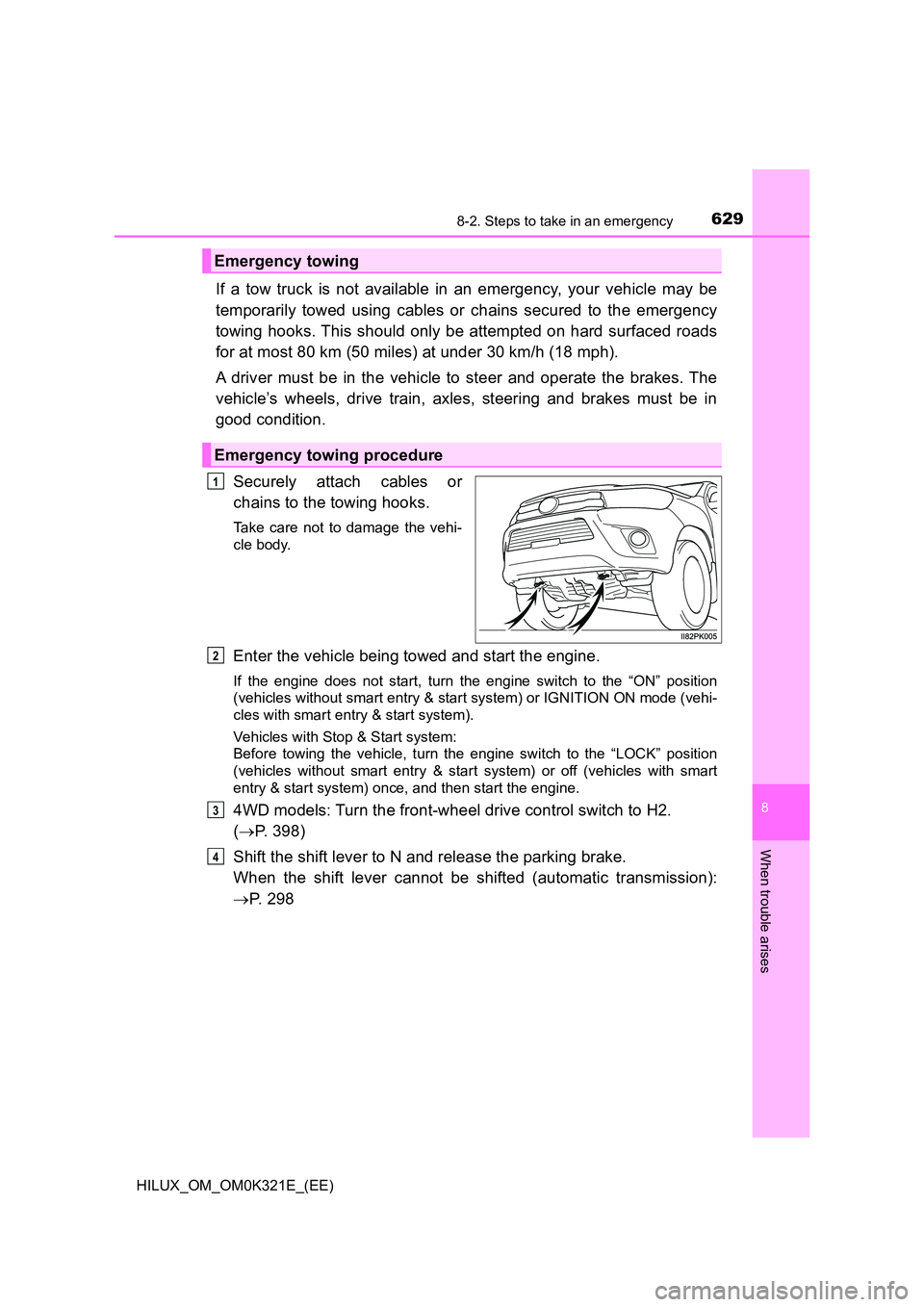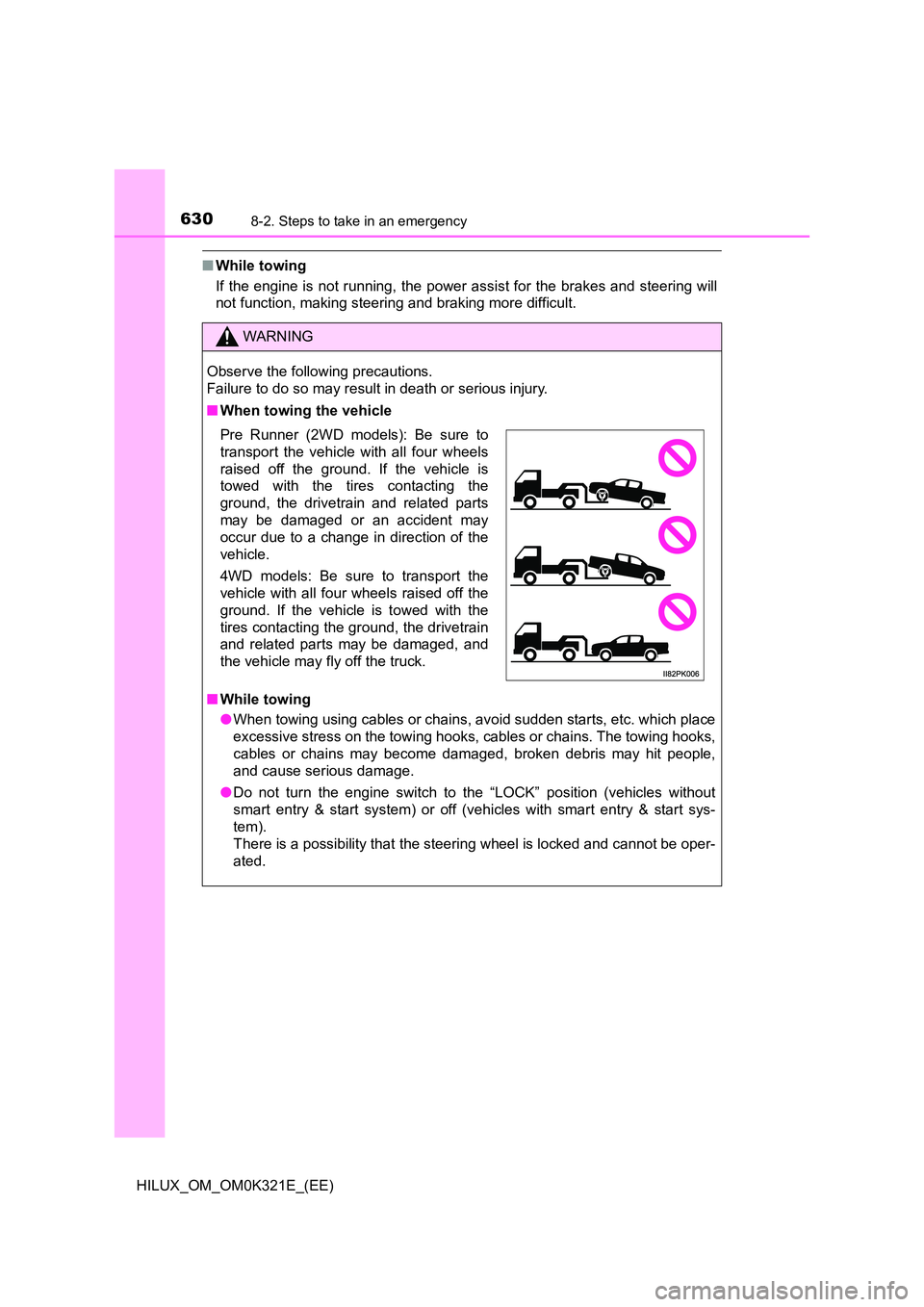Page 628 of 744
6288-2. Steps to take in an emergency
HILUX_OM_OM0K321E_(EE)
If your vehicle is transported by a
flatbed truck, it should be tied
down at the locations shown in the
illustration.
When attaching the hooks to the
rear of the vehicle, make sure to
attach them to the inside of the
vehicle.
If you use chains or cables to tie
down your vehicle, the angles
shaded in black must be 45 .
Do not overly tighten the tie
downs or the vehicle may be dam-
aged.
Towing with a wheel-lift type truck
From the frontFrom the rear
Use a towing dolly under the rear
wheels.
Use a towing dolly under the
front wheels.
Using a flatbed truck
Page 629 of 744

6298-2. Steps to take in an emergency
HILUX_OM_OM0K321E_(EE)
8
When trouble arises
If a tow truck is not available in an emergency, your vehicle may be
temporarily towed using cables or chains secured to the emergency
towing hooks. This should only be attempted on hard surfaced roads
for at most 80 km (50 miles) at under 30 km/h (18 mph).
A driver must be in the vehicle to steer and operate the brakes. The
vehicle’s wheels, drive train, axles, steering and brakes must be in
good condition.
Securely attach cables or
chains to the towing hooks.
Take care not to damage the vehi-
cle body.
Enter the vehicle being towed and start the engine.
If the engine does not start, turn the engine switch to the “ON” position
(vehicles without smart entry & start system) or IGNITION ON mode (vehi-
cles with smart entry & start system).
Vehicles with Stop & Start system:
Before towing the vehicle, turn the engine switch to the “LOCK” position
(vehicles without smart entry & start system) or off (vehicles with smart
entry & start system) once, and then start the engine.
4WD models: Turn the front-wheel drive control switch to H2.
( P. 398)
Shift the shift lever to N and release the parking brake.
When the shift lever cannot be shifted (automatic transmission):
P. 2 9 8
Emergency towing
Emergency towing procedure
1
2
3
4
Page 630 of 744

6308-2. Steps to take in an emergency
HILUX_OM_OM0K321E_(EE)
■While towing
If the engine is not running, the power assist for the brakes and steering will
not function, making steering and braking more difficult.
WARNING
Observe the following precautions.
Failure to do so may result in death or serious injury.
■ When towing the vehicle
■ While towing
● When towing using cables or chains, avoid sudden starts, etc. which place
excessive stress on the towing hooks, cables or chains. The towing hooks,
cables or chains may become damaged, broken debris may hit people,
and cause serious damage.
● Do not turn the engine switch to the “LOCK” position (vehicles without
smart entry & start system) or off (vehicles with smart entry & start sys-
tem).
There is a possibility that the steering wheel is locked and cannot be oper-
ated.
Pre Runner (2WD models): Be sure to
transport the vehicle with all four wheels
raised off the ground. If the vehicle is
towed with the tires contacting the
ground, the drivetrain and related parts
may be damaged or an accident may
occur due to a change in direction of the
vehicle.
4WD models: Be sure to transport the
vehicle with all four wheels raised off the
ground. If the vehicle is towed with the
tires contacting the ground, the drivetrain
and related parts may be damaged, and
the vehicle may fly off the truck.
Page 631 of 744

6318-2. Steps to take in an emergency
HILUX_OM_OM0K321E_(EE)
8
When trouble arises
NOTICE
■To prevent damage to the vehicle when towing using a wheel-lift type
truck
● Do not tow the vehicle from the rear when the engine switch is in the
“LOCK” position or the key is removed (vehicles without smart entry & start
system) or the engine switch is turned to off (vehicles with smart entry &
start system). The steering lock mechanism is not strong enough to hold
the front wheels straight.
● When raising the vehicle, ensure adequate ground clearance for towing at
the opposite end of the raised vehicle. Without adequate clearance, the
vehicle could be damaged while being towed.
■ To prevent damage to the vehicle when towing with a sling-type truck
Do not tow with a sling-type truck, either from the front or rear.
■ To prevent damage to the vehicle during emergency towing
Do not secure cables or chains to the suspension components.
■ When towing a vehicle equipped with the Stop & Start system (if
equipped)
When it is necessary to tow the vehicle with all four wheels contacting the
ground, perform the following procedure before towing the vehicle to protect
the system.
Turn the engine switch to the “LOCK” position (vehicles without smart entry
& start system) or off (vehicles with smart entry & start system) once, and
then start the engine. If the engine does not start, turn the engine switch to
the “ON” position (vehicles without smart entry & start system) or IGNITION
ON mode (vehicles with smart entry & start system).
Page 662 of 744
6628-2. Steps to take in an emergency
HILUX_OM_OM0K321E_(EE)
Type C
Lay down the tire with the valve
stem facing up and install the
holding bracket, inserting the
claw into the wheel lug nut hole.
Turn the jack handle extension
clockwise to take up slack in
the chain.
Then, check to ensure the claw is
in the wheel lug nut hole and the
holding bracket is centered in the
wheel hub.
Holding bracket
Claw
WARNING
■ Stowing the flat tire
Failure to follow steps listed under stowing the tire may result in damage to
the spare tire carrier and loss of the tire, which could result in death or seri-
ous injury.
Stowing the flat tire, jack and all tools
incorrect
correct
1
1
2
Page 663 of 744
6638-2. Steps to take in an emergency
HILUX_OM_OM0K321E_(EE)
8
When trouble arises
Raise the tire.
While raising, secure the tire, tak-
ing care that the tire goes straight
up without catching on any sur-
rounding part, to prevent it from fly-
ing forward during a collision or
sudden braking.
After the tire goes half way up,
check that the suspended chain is
able to enter the tire hole, for
proper storage.
Tightening torque:
37.0 N•m (3.8 kgf•m, 27.3 ft•lbf)
Confirm that the tire is not loose
after tightening:
Push and pull the tire
Try rotating
Visually check to ensure the tire is
not hung on surrounding parts.
If looseness or misassembly exists, repeat step and step .
Repeat step , any time the tire is lowered or disturbed.
Push in the projection on the
jack handle and disassemble
the jack handle end, jack han-
dle extensions and wheel nut
wrench.
Stow the tools and jack securely.
2
3
1
2
23
43
5
6
Page 665 of 744
6658-2. Steps to take in an emergency
HILUX_OM_OM0K321E_(EE)
8
When trouble arises
WARNING
■After using the tools and jack
Before driving, make sure all the tools and jack are securely in place in their
storage location to reduce the possibility of personal injury during a collision
or sudden braking.
NOTICE
■ When stowing the flat tire
Ensure that there is no object caught between the tire and the vehicle
underbody.
■ When assembling the jack handle extension
Insert the square head securely until you hear a click. Otherwise the exten-
sion may come off and it may damage the paint or vehicle body.
Page 684 of 744

6848-2. Steps to take in an emergency
HILUX_OM_OM0K321E_(EE)
WARNING
■When attempting to free a stuck vehicle
If you choose to push the vehicle back and forth to free it, make sure the
surrounding area is clear to avoid striking other vehicles, objects or people.
The vehicle may also lunge forward or lunge back suddenly as it becomes
free. Use extreme caution.
■ When shifting the shift lever
For vehicles with automatic transmission, be careful not to shift the shift
lever with the accelerator pedal depressed.
This may lead to unexpected rapid acceleration of the vehicle that may
cause an accident resulting in death or serious injury.
NOTICE
■ To avoid damage to the transmission and other components
● Avoid spinning the wheels and depressing the accelerator pedal more
than necessary.
● If the vehicle remains stuck even after these procedures are performed,
the vehicle may require towing to be freed.
● Vehicles with automatic transmission: When a warning message for the
automatic transmission fluid temperature is displayed while attempting to
free a stuck vehicle, immediately remove your foot from the accelerator
pedal and wait until the warning message disappears. Otherwise, the
transmission may become damaged. ( P. 299)